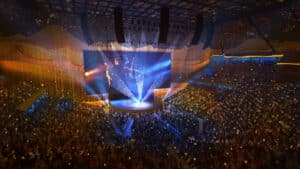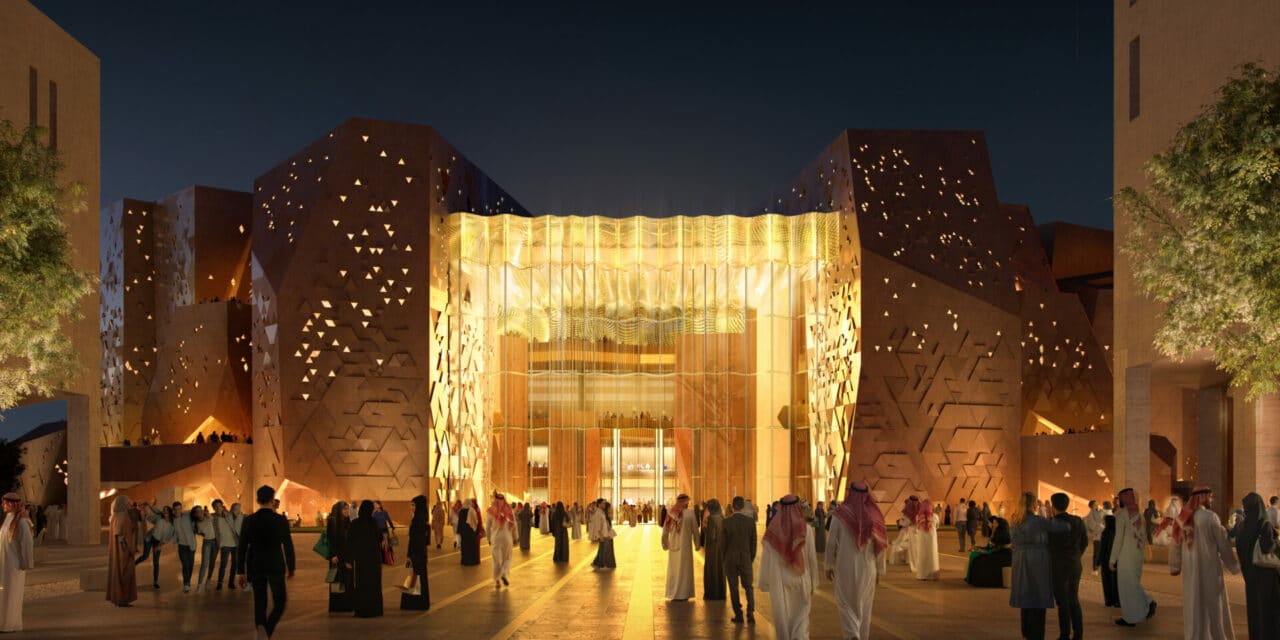LIGHT SHOW: HKS’ design of a new arena in Riyadh, Saudi Arabia, mixes traditional architecture with cutting-edge LED systems. (Courtesy HKS)
Centerhung splits into smaller screens depending on event
The next generation of videoboard technology is taking place in Saudi Arabia, where HKS has designed a $1 billion arena with roving LED screens above the seating bowl, customized for events.
The technology is the first of its kind for a public assembly venue, said Alex Thomas, design director for HKS and a company principal.
The 20,000-seat venue in Riyadh, the capital of Saudi Arabia, is part of Diriyah Gate, a massive $63 billion mixed-use development, encompassing retail, hotels, restaurants, an art museum, opera house, a grand mosque, exhibit hall, housing and a small amphitheater.
The overall development is being financed by the Public Investment Fund, the sovereign wealth fund of Saudi Arabia.
The centerpiece of Diriyah Gate is a multipurpose arena, expected to break ground in late summer and open in late 2026, Thomas said.
Riyadh sits in the center of the Arabian Peninsula, surrounded by desert, and with 63% of Saudi Arabia’s population under the age of 30, according to the 2022 census, the younger demographics are driving the need for new entertainment options. The arena is a key component of Saudi Vision 2030, a program tied to promoting cultural growth in the region, Thomas said.
Technology stands center stage at the arena, which will be primarily a live entertainment facility. To date, there is no sports tenant, but that could change in the future, Thomas said. The vision is for the arena to play host to international competitions, whether it’s basketball, hockey or other Olympic sports. HKS’ design is focused on programming for 70% live entertainment and 30% sports.
With concerts dominating the calendar, the typical centerhung board used for sports would split into smaller pieces to accommodate events of all sizes, given that touring artists typically bring their own video productions.
The four panels making up the centerhung will be assembled on tracks along the roof line as part of a mechanized system that allows each panel to move independently, whether it’s to the sides or the ends of the arena, Thomas said. They could also pivot 360 degrees to face different directions.

CENTER OF ATTENTION: The arena’s centerhung videoboard is designed to separate into smaller screens depending on the event, as shown in a rendering. (Courtesy HKS)
“We’re designing a whole new city, basically, without knowing who the tenants will be, and have designed the arena to be as flexible as possible,” he said. “We also wanted to introduce opportunities for creative use of digital media and come up with a new scheme to serve the standard configurations for sports with the ability to reconfigure space for the client. It’s all about adaptability, to load and create an LED backdrop for a small concert by a local performer or an esports event.”
The mechanization increases the cost of the traditional centerhung system, although Thomas did not have the numbers in hand to say how much it would escalate.
The concrete walls framing the arena exterior also showcase LED technology as part of a striking facade, that architecturally, fits with the rest of the landscape in Riyadh. Thomas described those structures as “stone monoliths,” designed to mimic the natural resources found across Saudi Arabia.
The stone walls are separated by a 45-foot-tall glass facade, integrated with LED lighting into the transparent, curved structure, which operates as high-tech animation feature to shine a rainbow of colors on public spaces outside the building.
“There’s a contrast between the heavy stone of the monoliths and the glass wall,” Thomas said.”The idea is to have a blank canvas of digital media to create movement on event days. The digital waterfall also serves as a backdrop to events happening outside the building to display content around outdoor activities and sponsorship activations.”
HKS won an international design competition for the arena job.. All told, the architect has has been working in Saudi Arabia for about 15 years in the healthcare space and its projects include two hotels that are part of Diriyah Gate. HKS is in position to expand its work across the mixed-use development in the future, Thomas said.
“The arena, because it’s in the heart of the capital city, is considered the most prestigious location,” he said. “It’s one of the projects that’s close to Mohammad bin Salman Al Saud, the crown prince of Saudi Arabia, and his royal family.”







